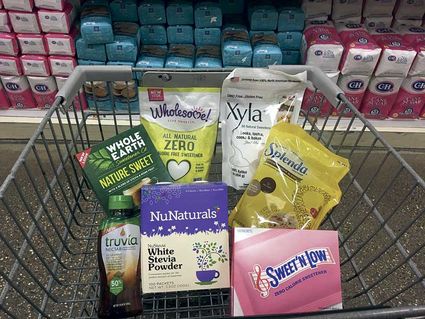So many alternatives to sugar
April 1, 2017

William Walters photo
From monk fruit to Xylitol, keeping up with the many varieties of today's sugar replacements requires homework and trial and error.
As a one-time professional baker (only slightly famous), I am well acquainted with the magic of sugar – a comforting sweetness, a foil for bitter, spicy and sour flavors and an essential for moist, tender and light baked products. In my more recent role as a registered dietitian, I am also aware of the pitfalls of eating too much sugar – cavities, obesity, elevated blood sugar levels and increased risk of heart disease.
We are pretty clear how sugar leads to obesity, dental decay and diabetes; but the way in which sugar contributes to heart disease is not as well understood. Nonetheless, the science is strong enough that American Heart Association recommends consuming no more than six teaspoons (24 grams) of added sugar per day for women, nine teaspoons (36 grams) for men and 4 teaspoons (16 grams) for children. For a quick reference: an average 12-ounce regular soda contains 9 ½ to 11 teaspoons of sugar, and sweetened breakfast cereal may deliver between 2 and 12 teaspoons of sugar per serving.
Choosing your sweetener
With the association between eating too much sugar and serious health consequences, you may wonder if you should toss out the sugar bowl in favor of those little pink, blue, and yellow packets of artificial sweetener. The answer depends upon the amount of sugar you consume now, your health concerns and whether you are hoping to bake a delicious, moist birthday cake. There are a number of options that may help you meet your goals of reduced sugar.
Artificial sweeteners have been around since the discovery of saccharin in the late 1800s and there are now five approved, calorie-free artificial sweeteners in the U.S. They are commonly used in beverages, frozen desserts and many packaged foods.
• Saccharin
• Aspartame
• Acesulfame – K
• Sucralose
• Neotame
These products have been given the Food and Drug Administration's "GRAS" (generally recognized as safe) designation. This means that the FDA believes that they are safe for use by the public when consumed in reasonable amounts.
If you've been alive for more than half a century, you will remember that saccharin, aspartame and a now banned sweetener, cyclamate, were suspected of causing cancer. After more research, cyclamate was ultimately removed from the market in the U.S and the five now permitted are safe when consumed in moderation.
Still, credible university-based nutrition experts and scientifically rigorous "watchdog" groups caution that evidence of safety isn't the same thing as absolutely no evidence of potential harm. Some artificial sweeteners have been associated with cancer in animals (but not humans) and associated with the very problems they are supposed to prevent – weight gain, metabolic syndrome and diabetes. But, the experts also conclude that if artificial sweeteners help you lose weight or control your blood sugar levels, by all means use them.
Benefits and drawbacks
Artificial sweeteners offer intense, calorie-free sweetness. They don't promote tooth decay or raise blood sugar levels. One of their biggest drawbacks is a lingering aftertaste. They have also proved less versatile as they don't provide the tenderizing and volume we want in a cake.
They will work well in beverages, pudding, gelatin desserts, lattes and things like zucchini or banana bread that derive texture from other ingredients.
If you want to cook with artificial sweeteners, go to their websites and get recipes designed specifically for the product. The baking aisle at the grocery store also offers sweeteners that combine calorie-free sweeteners with sugar, giving better baking results and better flavor with fewer calories - the end product will usually have about one-third fewer calories than a product made with sugar.
Newer options
If you want to stick with a calorie-free but natural option, there are two, more recently FDA approved sweeteners – Stevia and Luo Han Guo (aka Monk Fruit). These are from plants that have traditionally been used for sweetening in South America and South East Asia. They have not been associated with any health concerns and may be useful for weight loss and controlling blood sugar. But, they are stuck with some of the same flavor and texture concerns as artificial sweeteners.
Pure stevia extract has an aftertaste some describe as bitter, and monk fruit has a fruit flavor and lacks some intensity. As powders or liquids, they don't provide the tenderizing quality of sugar but they can be used in similar situations as the artificial sweeteners.
Flavor chemists have found that stevia's flavor can be balanced effectively by combining it with sugar. This may be one of the ways that you can use it at home for creating lower calorie and lower sugar cakes, cookies and beverages. One of the first companies to use this laboratory discovery was Coca-Cola in their Coca Cola Life®. A twelve-ounce bottle of Coca Cola Life® contains 90 calories (6 teaspoons of sugar) compared to the usual 140 to 150 calories (10 teaspoons of sugar) in most colas.
Stevia can reportedly cause allergy troubles. If an individual is allergic to ragweed, daisies, chrysanthemum or sunflower, he or she may be allergic to stevia.
Xylitol and erythritol
Xylitol and erythritol are additional natural sweetening options that pose no chronic disease health risks. They are naturally occurring compounds found in many plants and the commercially marketed versions of these sweeteners are derived from corn or trees. They look and taste like sugar, have no aftertaste and can be used successfully in liquids and baked goods although baked products may be slightly dryer and tougher.
Neither sweetener contributes to tooth decay and neither raises blood sugar levels significantly despite the fact that xylitol provides 10 calories per teaspoon; erythritol is considered calorie-free. If you are going to get carried away with one of these sweeteners, be aware that excess consumption of xylitol can result in diarrhea and abdominal pain.
Testing, tasting
I put my baker's hat back on and did a little experiment with a simple cake recipe using sugar, erythritol or sucralose. To the baker (me), the cake made with sugar had a superior texture, flavor, volume and color. Coming in second was the cake with erythritol – it had a little less volume and was slightly dryer. My last place went to the sucralose cake with very poor volume, toughness and aftertaste.
Taking my experiment a little further, I was surprised that a self-described "less discriminating" audience of about 10 people rated the flavors and textures as roughly similar and all enjoyable. This must be considered good news for reducing sugar in your diet even if it doesn't sit right with an only slightly famous baker.
Decisions, decisions
So, should you start using a sugar substitute? Start with figuring out how much sugar you eat now (count the sugar in your breakfast cereal, granola bars, yogurt, jam, graham crackers, packaged iced tea, etc). If you already meet the American Heart Association guidelines and you have no special medical needs, you can probably avoid the effort.
If you need to lose weight or lower your blood sugar levels, you have many options for achieving those goals. You can eat fewer high-sugar or high-calorie foods. But, using some of the many sugar substitutes may allow you to eat nearly the same foods, in the same amounts with a smaller effect on your blood sugar, teeth, heart and waistline.
For more information on reducing sugar in your diet or sugar substitutes feel free to contact: Leslie Shallcross at 907-474-2426.
Leslie Shallcross is a registered dietitian and associate professor at University of Alaska Fairbanks School of Natural Resources and Extension.











